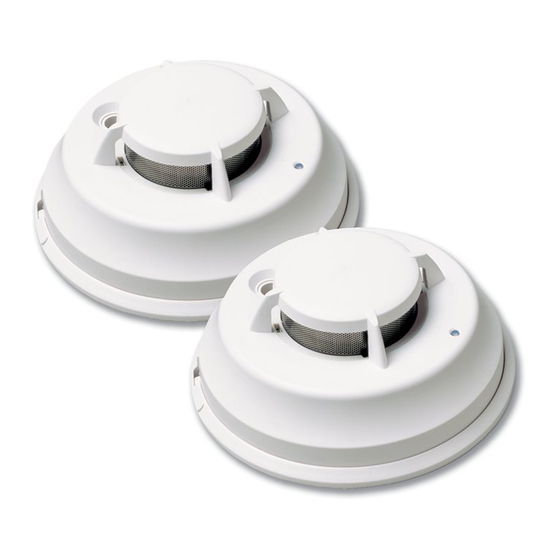DSC FSA-410D Series Installation And Operating Instructions - Page 3
Browse online or download pdf Installation And Operating Instructions for Smoke Alarm DSC FSA-410D Series. DSC FSA-410D Series 4 pages. Fsa-410d series

Owners Instructions
Fire Safety In The Home
Most fires occur in the home, and to minimize this danger, it is
recommended that a household fire safety audit be conducted
and a family escape plan be developed.
Household Fire Safety Audit
1.
Are all electrical appliances and outlets in safe condition?
Check for frayed cords, overloaded lighting circuits, etc. If
you are uncertain about the condition of your electrical
appliances or household service, have a professional evalua-
tion.
2.
Are all flammable liquids safely stored in closed containers,
and in a cool and well ventilated area? Avoid cleaning the
unit with flammable liquids.
3.
Are hazardous materials such as matches out of the reach of
children?
4.
Are furnaces and wood burning appliances properly
installed, clean, and in good working order? If in doubt,
have a professional evaluation.
Family Escape Planning
There is often very little time between the detection of a fire and
the time it becomes deadly. Because of this, it is very important
that a family escape plan be developed and rehearsed.
•
Include every family member when developing the escape
plan.
•
Study the possible escape routes from each location within
the house. Since many fires occur at night, give special
attention to the escape routes from sleeping quarters.
•
It is essential that escape from a bedroom be possible with-
out opening the interior door. Consider the following when
making your escape plans:
•
Ensure that doors and windows that open to the outside are
easily opened. Ensure that they are not painted shut and
that the locking mechanisms operate smoothly.
•
Develop specific rescue plans if opening the exit or using the
exit is too difficult for children, the elderly or handicapped.
This plan includes making sure that those who are to per-
form the rescue can promptly hear the fire warning signal.
•
If the exit is above the ground level, provide an approved fire
ladder or rope, as well as training in its use.
•
Keep exits on the ground level clear. Be sure to remove snow
from exterior patio doors in the winter and that outdoor fur-
niture or equipment does not block exits.
•
Have a predetermined assembly point where everyone can
be accounted for; for example, across the street or at a
neighbour's house.
•
Once everyone is out of the house, call the Fire Department.
•
A good plan emphasizes a quick escape. Do not investigate
first or attempt to fight the fire, and do not attempt to res-
cue belongings or valuables as this takes up time. Once out-
side, do not re-enter the house; wait for the Fire
Department.
•
Write the plan down and rehearse it frequently so that
should an emergency ever arise, everyone will know what to
do. Revise the plan as conditions change; for example, when
there are more or fewer family members in the home or if
there are changes to the house.
•
Make sure your fire warning system is operational by con-
ducting weekly tests. If you are unsure about system opera-
tion, contact your smoke detector installer or dealer.
•
DSC recommends that you contact your local Fire Depart-
ment and request further information on home fire safety
and escape planning. If available, have your local fire pre-
vention officer conduct an in-house fire safety inspection.
Testing Your Smoke Alarm
Follow the test procedure described here or contact your smoke
alarm dealer or installer for testing instructions.
DSC recommends that you test the entire alarm system at least
once a week to verify the operation of all system functions.
To test the smoke alarm, press and hold the test button on the
front of the unit for 5 seconds minimum, the sounder initiates a
clicking noise during this time. When the button is pressed, the
unit's alarm will sound, the LED will shut off and the relay will be
activated. When the button is released, the alarm will cease.
Upon completing the functional testing of the smoke alarm,
check the unit's sensing chamber to ensure proper operation. To
test the sensing chamber, wave a lit cotton wick or punk stick
around the outside of the unit until a generous amount of
smoke enters the sensing chamber or the unit alarms. If the
smoke detector does not function properly, call your smoke
alarm installer or dealer for service.
Maintenance
The smoke alarm is designed to require minimum maintenance.
If the case becomes dusty, vacuum with a small brush attach-
ment. If the case is greasy, wipe the case gently with a soft cloth
slightly dampened with soapy water.
Never disassemble the smoke alarm; there are no user service-
able parts inside the unit. Never paint the unit. Paint may pre-
vent smoke from entering the unit. If you are planning
renovations or repainting, contact your installer and ask that the
unit be temporarily removed until work is complete.
If the unit is located in an area where it is exposed to high levels
of dust or insects and causes false alarms, it may require service;
contact your smoke alarm installer or dealer.
Testing and maintenance procedures shall be in accordance with
the CAN/ULC-S552 standard.
